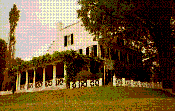Aspet, Saint-Gaudens National Historic Site |
|
|
Site: N08-41
|
Aspet. Built about 1800 as an inn, this Federal style, brick house was known locally as Huggins' Folly. Saint-Gaudens renamed it Aspet in honor of his father's French birthplace and, after 1885, added dormers and the west porch piazza with its ionic columns. The house retains original furnishings and decorative objects from Saint-Gaudens' travels. The majestic tree in front is a thornless honey locust, planted in 1886.
(Source 164) Although Augustus Saint-Gaudens' name has always been linked with the Cornish Colony, although he was indeed its leading figure for some twenty years, and although his memory is fittingly commemorated by the preservation of his home and studio here as a National Historic Site, he was not the founder of the Colony. That honor falls unquestionably to Charles Cotesworth Beaman, the rising New York lawyer who became interested in the young French-Irish sculptor who while still a student in Rome was commissioned by the future Mrs. Beaman to do two busts of Cicero and Demosthenes for her father, William Maxwell Evarts. When Saint-Gaudens returned to New York in 1874, he was commissioned by the New York Bar Association to do a bust of Beaman's newly acquired father-in-law, and Beaman made the arrangements with the young sculptor. Their friendship flowered, and Beaman lured Saint-Gaudens to Cornish in 1885 with the promise that he would find "plenty of Lincoln-shaped men" there, since the sculptor was then beginning work on his "Standing Lincoln" for Lincoln Park in Chicago. Beaman offered to sell him a fine brick house with stepped gables, the William Mercer place, which had fallen upon evil days after its construction, around 1805, by Jonas B. Huggins and his brother Samuel in the hope that it would become a profitable tavern on an anticipated highway over the hills to Cornish Flat, Meriden, and Newport. The cross-state highway failed to materialize, however, and the building became known as "Huggins' Folly" and degenerated at one time into a house of ill fame, after the Huggins moved to Illinois in the 1830s. Beaman offered the house to Saint-Gaudens for the modest sum of $500, but the city-bred sculptor, seeing it first on a gloomy mud-season day, found it "forbidding and relentless," and liked only the large barn, which he thought had possibilities as a studio. The "Blow-Me-Down Record" for April 25,1885, reads: "After many changes of mind we came up--Augusta H. St. Gaudens. We did not change our minds, but H.(ettie) S. B.(eaman) did.--Augustus St. Gaudens." But "Madame" Saint-Gaudens, who had a mind of her own and the means to go with it, liked the place and persuaded her husband to accept Charles Beaman's alternative offer to rent the place to them for a modest sum, provided that they made any alterations at their own expense. They took the house for only one summer, but after that first year Saint-Gaudens declared that he had accomplished more in Cornish than in all the earlier hot summers in New York, and wanted to buy the place. But Charles Beaman was now reluctant to sell (though willing to rent to Saint-Gaudens almost indefinitely for a nominal sum), for he anticipated that one of his own children might eventually want the place. It was not until 1891 that Beaman agreed to sell "Blow-Me-Up," as he called it, for $2,500 and a bas-relief portrait of himself. It is not recorded whether the quintupling of the price in six years reflected the inflation of real estate values by the rapidly growing popularity of the Colony or Saint-Gaudens' much improved financial circumstances. Beaman was a lawyer who adjusted his fees to his client's ability to pay, and who followed the same policy in disposing of his Cornish properties. If Saint-Gaudens' growing fame and wide acquaintance among artists were the chief factors that brought so many of them to Cornish, it was Charles Beaman's generosity that enabled them to stay and make homes as permanent here as artists are apt to have.
The new proprietors of "Huggins' Folly," who christened it "Aspet" after the birthplace of Saint-Gaudens' father in France, soon radically changed its grim appearance. One friend observed that the white porch pillars they installed made it look like an old New Hampshire farmer with a new set of false teeth. Another found that the old house, now encircled with classic pergolas, looked like a New England old maid struggling in the arms of a satyr. Mrs. Daniel Chester French, who with her sculptor husband lived in Cornish during the summers of 1891 and 1893, described an elaborate fence, with Greek heads at regular intervals, at the top of the bank on which the house sat, and the big porch looking toward Ascutney on which the Saint-Gaudens family ate its meals. The Frenches were later to copy this latter arrangement in their own Stockbridge, Massachusetts, home. With the aid of flower beds and white pine and hemlock hedges, "Aspet" evoked southern France rather than northern New England, and boasted such exotic resources as a rough-mowing golf course in summer and a toboggan slide starting on the studio roof in winter.
|
BACK TO NATIONAL REGISTER PROPERTIES
